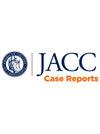Usefulness of Echocardiography Contrast Agents for the Detection of Residual Leak After Percutaneous LAA Closure Device Implantation
Q4 Medicine
引用次数: 0
Abstract
Background
Residual leaks after percutaneous left atrial appendage closure (LAAC) are associated with an increase in thromboembolic events. Therefore, their detection and correction are crucial.
Case Summary
This case was a 78-year-old woman with history of long-standing atrial fibrillation complicated by transient ischemic attack who underwent a percutaneous LAAC with a WATCHMAN device, with no residual leak. Initial follow-up transesophageal echocardiography (TEE) was unremarkable and anticoagulation therapy was stopped. Subsequent TEE was performed due to abnormal gap around the device noted on cardiac computed tomography. TEE findings were concerning for residual leak by color Doppler, but a definite diagnosis could not be made. An echo contrast agent was then used, which helped establish a definite diagnosis of residual leak and helped guide further management.
Discussion
This is the first case to show the usefulness of echo contrast agents to detect residual leaks after LAAC.
Take-Home Message
The use of contrast agents during TEE represents a low-cost and readily available tool that may become an alternative to cardiac computed tomography for the detection of residual leaks after LAAC in challenging cases, when color Doppler is inconclusive.
超声心动图造影剂对经皮LAA闭合器植入后残留渗漏检测的价值
背景:经皮左心耳闭合(LAAC)后残留的漏与血栓栓塞事件的增加有关。因此,检测和纠正它们是至关重要的。病例摘要:该病例是一名78岁女性,有长期房颤合并短暂性脑缺血发作病史,采用WATCHMAN装置经皮LAAC,无残留渗漏。初步随访经食管超声心动图(TEE)无明显异常,并停止抗凝治疗。由于在心脏计算机断层扫描上发现设备周围有异常间隙,随后进行TEE。TEE的发现与彩色多普勒的残余渗漏有关,但不能做出明确的诊断。然后使用回声造影剂,这有助于确定残余泄漏的明确诊断,并有助于指导进一步的处理。这是第一个显示超声造影剂检测LAAC后残余渗漏有用性的病例。在TEE期间使用造影剂是一种低成本且容易获得的工具,在具有挑战性的病例中,当彩色多普勒不确定时,它可能成为心脏计算机断层扫描检测LAAC后残余泄漏的替代方法。
本文章由计算机程序翻译,如有差异,请以英文原文为准。
求助全文
约1分钟内获得全文
求助全文
来源期刊

JACC. Case reports
Medicine-Cardiology and Cardiovascular Medicine
CiteScore
1.30
自引率
0.00%
发文量
404
审稿时长
17 weeks
 求助内容:
求助内容: 应助结果提醒方式:
应助结果提醒方式:


